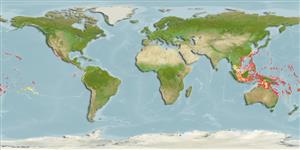>
Gobiiformes (Gobies) >
Gobiidae (Gobies) > Gobiinae
Etymology: Eviota: No etymology given, suggested by Christopher Scharpt: from Latin 'eu' for 'true' and 'iota' for anything very small, in combination 'truly very small' referring to it as being the smallest vertebrate at the time it has benn described by Jenkins (thus, making the suggestion by Scharpt plausible..
More on authors: Jordan & Seale.
Environment: milieu / climate zone / depth range / distribution range
Ecologia
marinhas associadas(os) a recifes; intervalo de profundidade 0 - 40 m (Ref. 107299). Tropical; 30°N - 30°S
Western Pacific: Japan (Ryukyu and Ogasawara islands), Taiwan, the Philippines and south to Australia and Norfolk Is.; east to Vanuatu, Fiji, Wallis and Futuna, Tonga and Samoa, including Palau, Guam and Marshall Islands in Micronesia.
Tamanho / Peso / Idade
Maturity: Lm ? range ? - ? cm
Max length : 2.3 cm SL macho/indeterminado; (Ref. 1602)
Descrição breve
Chaves de identificação | Morfologia | Morfometria
Espinhos dorsais (total) : 7; Raios dorsais moles (total) : 8 - 9; Espinhos anais: 1; Raios anais moles: 7 - 8. This species is distinguished by the following characters: complete cephalic sensory-canal pore system (pattern 1); the fifth pelvic-fin ray 10-40% (usually 20%) of fourth ray; some pectoral-fin rays are branched; dorsal/anal-fin formula 9/8; presence of a prominent occipital spot; dorsal midline of body with a series of small dark spots along the dorsal-fin bases; dark bars present crossing the nape in advance of dorsal fin; caudal-peduncle depth 13.4-14.9% SL (Ref. 107299).
Inhabits shallow waters, often including tide pools of exposed seaward reefs (Ref. 37816, 116739), usually in high-tide splash zones and at shallow depths (Ref. 107299).
Life cycle and mating behavior
Maturities | Reprodução | Spawnings | Egg(s) | Fecundities | Larvas
Myers, R.F., 1991. Micronesian reef fishes. Second Ed. Coral Graphics, Barrigada, Guam. 298 p. (Ref. 1602)
Categoria na Lista Vermelha da IUCN (Ref. 130435)
Ameaça para o homem
Harmless
Utilização humana
Pescarias: sem interesse
Ferramentas
Relatórios especiais
Descarregue XML
Fontes da internet
Estimates based on models
Preferred temperature (Ref.
123201): 24.7 - 29.3, mean 28.3 °C (based on 1537 cells).
Phylogenetic diversity index (Ref.
82804): PD
50 = 0.5000 [Uniqueness, from 0.5 = low to 2.0 = high].
Bayesian length-weight: a=0.01023 (0.00477 - 0.02194), b=3.02 (2.84 - 3.20), in cm total length, based on LWR estimates for this (Sub)family-body shape (Ref.
93245).
Nível Trófico (Ref.
69278): 3.1 ±0.3 se; based on size and trophs of closest relatives
Resiliência (Ref.
120179): Elevada, tempo mínimo de duplicação da população menor que 15 meses (Preliminary K or Fecundity.).
Fishing Vulnerability (Ref.
59153): Low vulnerability (10 of 100).
Nutrients (Ref.
124155): Calcium = 374 [160, 1,182] mg/100g; Iron = 1.74 [0.76, 3.78] mg/100g; Protein = 18 [16, 20] %; Omega3 = 0.175 [0.057, 0.516] g/100g; Selenium = 33.1 [10.6, 89.5] μg/100g; VitaminA = 121 [25, 572] μg/100g; Zinc = 4.49 [2.47, 7.46] mg/100g (wet weight);
